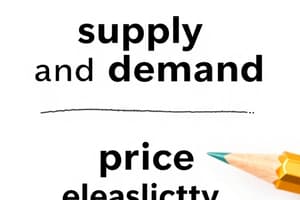Podcast
Questions and Answers
What does price elasticity of demand measure?
What does price elasticity of demand measure?
- The total revenue generated by sales.
- The slope of the demand curve.
- The change in quantity demanded based on price changes. (correct)
- The effect of consumer income on demand.
Which of the following is not a determinant of price elasticity of demand?
Which of the following is not a determinant of price elasticity of demand?
- Availability of substitutes.
- The time period for adjustment.
- Necessity versus luxury classification.
- Consumer income levels. (correct)
How does a steeper demand curve affect price elasticity?
How does a steeper demand curve affect price elasticity?
- It indicates lower elasticity. (correct)
- It shows that total revenue is unaffected by price changes.
- It indicates higher elasticity.
- It suggests equal responsiveness of quantity demanded to price changes.
What is the relationship between price elasticity of demand and total revenue?
What is the relationship between price elasticity of demand and total revenue?
Which type of elasticity measures the responsiveness of demand to changes in consumer income?
Which type of elasticity measures the responsiveness of demand to changes in consumer income?
What does an elasticity coefficient greater than 1 indicate about demand?
What does an elasticity coefficient greater than 1 indicate about demand?
Which of the following factors is NOT a determinant of price elasticity?
Which of the following factors is NOT a determinant of price elasticity?
What condition defines unitary demand?
What condition defines unitary demand?
If the coefficient of elasticity is less than 1, how is the demand characterized?
If the coefficient of elasticity is less than 1, how is the demand characterized?
In the context of price elasticity, what does an elasticity coefficient of 0.13 represent?
In the context of price elasticity, what does an elasticity coefficient of 0.13 represent?
Which of the following is true about elastic demand?
Which of the following is true about elastic demand?
What happens to the demand for a product when the percentage of household income spent on it increases significantly?
What happens to the demand for a product when the percentage of household income spent on it increases significantly?
Which product listed is most likely to have elastic demand based on typical consumption behaviors?
Which product listed is most likely to have elastic demand based on typical consumption behaviors?
Flashcards
Price Elasticity of Demand
Price Elasticity of Demand
A measure that reveals how much the quantity demanded of a good changes when its price changes.
Price Elasticity of Demand
Price Elasticity of Demand
It is a measure of how much the quantity demanded of a good changes in response to a change in its price.
Price Elasticity of Demand
Price Elasticity of Demand
A concept that helps us understand the responsiveness of quantity demanded to changes in price.
Price Elasticity of Demand
Price Elasticity of Demand
Signup and view all the flashcards
Price Elasticity of Demand
Price Elasticity of Demand
Signup and view all the flashcards
Elastic Demand
Elastic Demand
Signup and view all the flashcards
Inelastic Demand
Inelastic Demand
Signup and view all the flashcards
Unitary Demand
Unitary Demand
Signup and view all the flashcards
Elasticity Coefficient
Elasticity Coefficient
Signup and view all the flashcards
Determinants of Price Elasticity
Determinants of Price Elasticity
Signup and view all the flashcards
Products with Elastic Demands
Products with Elastic Demands
Signup and view all the flashcards
Products with Inelastic Demands
Products with Inelastic Demands
Signup and view all the flashcards
Study Notes
Chapter 4: Elasticity
- Learning Objectives:
- Explain price elasticity of demand and its determinants.
- Calculate price elasticity and explain the coefficient of elasticity.
- Describe the relationship between the slope of a demand curve and elasticity, and how this affects the producer's total revenue.
- Use real-world examples to demonstrate the power of the elasticity concept.
- Describe the meaning and significance of elasticity of supply, income elasticity, and cross-elasticity of demand.
Price Elasticity of Demand
- Definition: Price elasticity of demand measures how responsive the quantity demanded of a product is to a change in its price.
- Formula: εp = (%∆ quantity demanded) / (%∆ price)
- Coefficient of Elasticity: Represented by 'ε' (epsilon), it's an absolute number; the sign is ignored.
- Inelastic Demand: Quantity demanded is not very responsive to price changes. Elasticity coefficient is less than 1.
- Elastic Demand: Quantity demanded is quite responsive to price changes. Elasticity coefficient is greater than 1.
- Unitary Demand: Percentage change in quantity demanded is exactly equal to the percentage change in price. Elasticity coefficient is equal to 1.
Determinants of Price Elasticity
- Number of available substitutes
- Percentage of household income spent on the product
- Time period involved
Examples of Elasticities
- Table 4.2 lists examples demonstrating elastic and inelastic demands for various products. (Specific values are included in the table.)
Test Your Understanding (Questions and Answers)
- Presents scenarios inquiring about elasticity of demand for particular products (e.g., sugar, gasoline, ocean cruises, etc.) and asks to determine whether demand would be categorized as elastic or inelastic. Answers are given.
LO2: Measuring Price Elasticity
- Formula for calculating price elasticity Equation: εp = (ΔQd / average Qd) / (ΔP / average P) ×100
Elasticity vs. Slope
- Slope is rise over run. A straight-line demand curve has a constant slope.
- Elasticity is the percentage change in quantity over the percentage change in price.
- A straight-line demand curve's elasticity is variable across points on the curve.
- The upper half of the curve is elastic, and the lower half is inelastic.
Types of Elasticity
- Inelastic Demand: Percentage price change results in a smaller percentage quantity change.
- Unit Elastic Demand: Percentage price change and percentage quantity change are equal.
- Elastic Demand: Percentage price change results in a larger percentage quantity change.
Elasticity and Total Revenue
- If demand is elastic, an increase in price will cause total revenue to decrease. Conversely, a decrease in price will increase total revenue.
- The opposite is true when demand is inelastic.
Other Elasticity Measures
-
Elasticity of Supply: Measures how quantity supplied changes with regard to price changes. Formula provided.
-
Supply Elasticity in Three Periods:
- Market Period = Perfectly inelastic supply
- Short Run = Inelastic supply
- Long Run = Elastic supply
-
Income Elasticity: Measures responsiveness of quantity demanded to income changes. Formula included.
-
Cross-Elasticity of Demand: Measures responsiveness of quantity demanded of one good due to a change in the price of another good. Formula included
-
Summary of various elasticities: A diagram illustrating the ranges for price, income, and cross-elasticities.
Key Concepts to Remember
- Definition, calculation, and determinants of price elasticity of demand
- Difference between slope and elasticity
- Relationship between elasticity and total revenue
- Real-world examples of elasticity
- Elasticity of supply, income elasticity, and cross-elasticity of demand
Studying That Suits You
Use AI to generate personalized quizzes and flashcards to suit your learning preferences.



